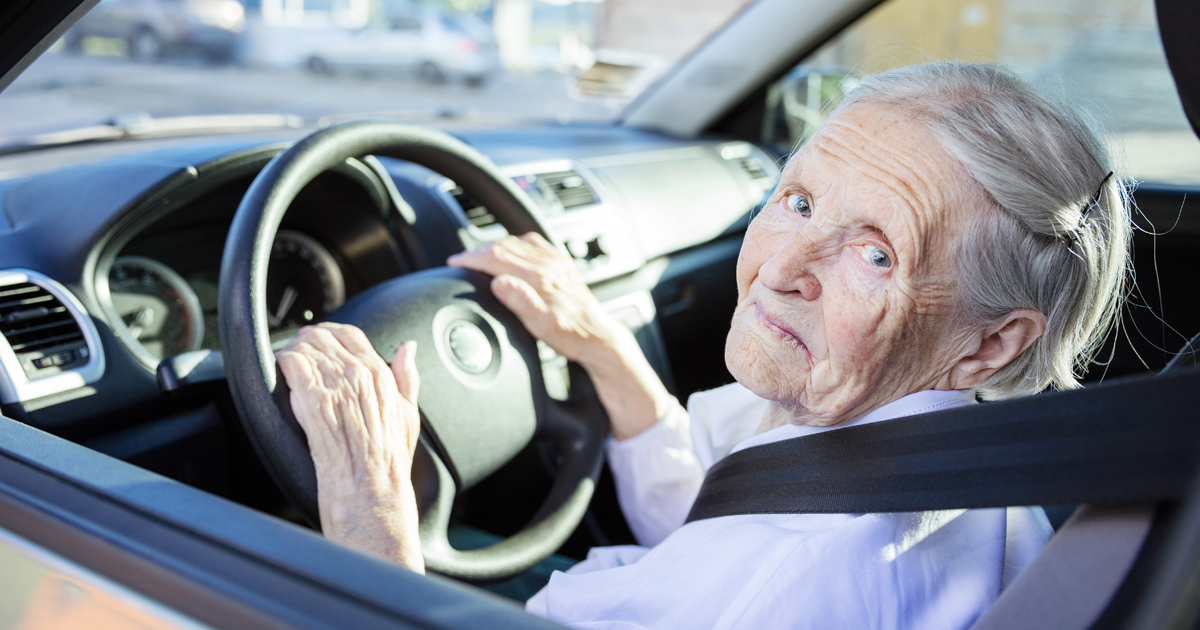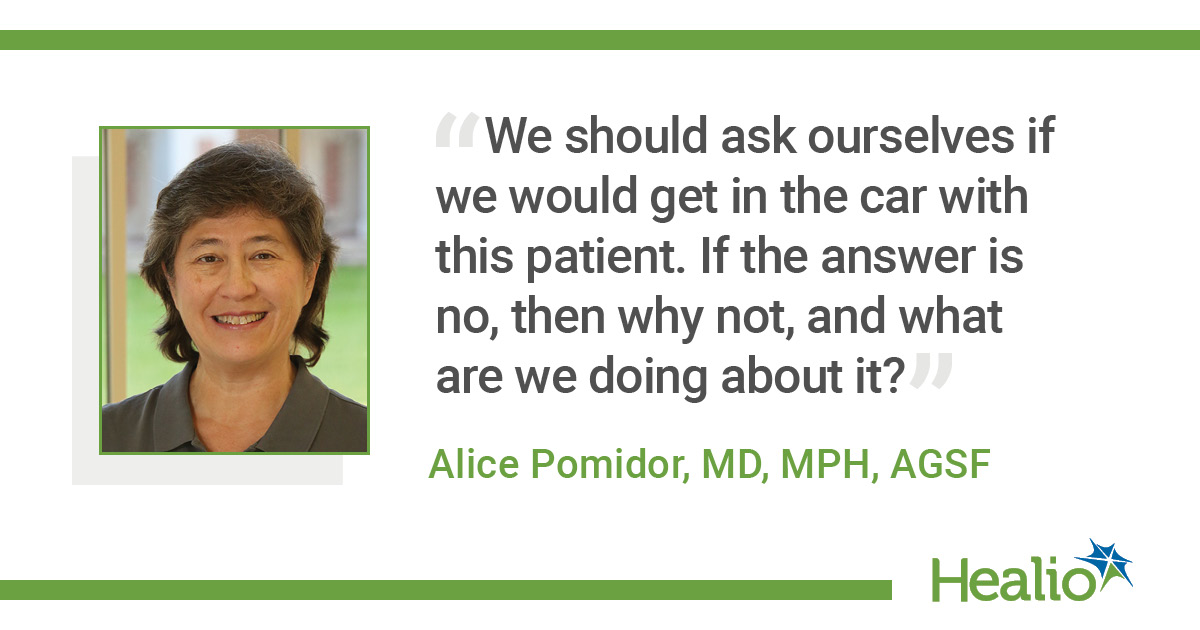When to ask older patients to stop driving is ‘not cut and dried’
AAA projects that approximately 20% of all drivers will be 65 years of age or older by 2030.
Primary care physicians play a critical role in assessing a patient’s driving ability, Larisa J.N. Hill, MD, MPH, of the Mayo Clinic School of Graduate Medical Education, told Healio Primary Care.
“PCPs are trusted, viewed as authority figures,” she said. “If we don’t discuss driving with our older patients, the patients may wrongly think that is still OK for them to drive.”
But how to tell which older patients should stop driving is not very clear, Alice Pomidor, MD, MPH, AGSF, a professor in the geriatrics department at the Florida State University College of Medicine, said during a presentation at an ACP annual meeting.

“Knowing when a patient has to hand over the keys is not cut and dried,” she said. “We want people to be able to move and drive, so long as they can safely.”
Healio Primary Care asked Hill and Pomidor to provide tips to PCPs on assessing older drivers’ abilities.
Discuss early, often
Pomidor mentioned that the first thing physicians need to do is assess how much patients depend on driving.
“Once people stop driving, and depending on their family and social network, it could impair their ability to get to us, see their loved ones, be social, and obtain food,” she said during the presentation.

Hill and Pomidor agreed that the best time for starting conversations about driving ability is when the patient is in their 40s or 50s.
“Starting to talk that talk with folks early gets them used to the idea, and it may even prolong their driving life expectancy,” Pomidor said.
For example, a 45-year-old with hyperglycemia is at risk for developing neuropathy. By the time the patient turns 70 years of age, he or she may not be able to tell the direction their foot is moving or distinguish between the pedals, according to Pomidor. Discussing when to stop driving early on is the same in principle as discussing the potential long-term impact of high blood sugar when the patient is middle-aged — he or she may be more receptive to treatment that reduces that risk when the time comes.
“If we never talk about driving until a caregiver brings it up or the patient has lost so much physical and cognitive ground it can’t be regained, the patient will have good reason to be upset or angry,” Pomidor said in an interview.
The conversation about driving ability also needs to occur more than once, Hill added.
“Studies have shown that patients want to have these conversations over time,” she said, adding that the tone and shape of the discussions will often differ among patients.
“These conversations are often very emotionally charged and will vary from person to person,” she said. “Keep the focus on a concern for their safety and their ongoing independence and mobility.”
Pomidor, who has edited publications on older driver safety, said PCPs need to bear in mind a new diagnosis, medication, or a change in a patient’s condition or functional abilities.
“A person who suffered a minor stroke will likely be at a different stage of recovery at 2 weeks than he or she is at 6 weeks,” Pomidor continued. “You may have to watchfully wait.”

Listen for warning signs
Patients may provide verbal cues that their driving ability is impaired, Pomidor noted.
“They may tell you, ‘I don’t like to drive at night because I don’t think it is safe,’” she said. “Or they come for a checkup after a minor accident, and they tell you they are only there because an emergency medical technician told them to do so after the accident.”
Pomidor and Hill indicated that PCPs should routinely assess patients’ vision, motor/sensory and cognitive skills as part of an individualized driving assessment process.
“There is no single tool that definitively decides what the most important skill is and how the patient should perform on it,” Hill explained.
“PCPs should choose the method of vision, motor or cognition testing that is most appropriate and helpful to you and your patient,” Pomidor added.
Hill said the goal of an in-clinic screening assessment is to “trichotomize” drivers into three risk categories.
According to Hill, patients considered “green light” drivers are those who are at low risk for unsafe driving and may continue driving at this time. This includes individuals without significant impairments in vision, physical function, or cognition and without uncontrolled medical conditions or high-risk medications.
In contrast, she said patients classified as “yellow light” drivers are those who:
- have been in an accident or experienced a close call in past year, or have a partner or family members who express concern about their driving;
- have reported a change in driving habits;
- take medications with potential to impact safe driving;
- have difficulty hearing, limited range of neck motion, a leg strength score of less than 4 and rapid pace walk scores of 9 seconds or less; and
- have Mini-Mental State Examination scores that are higher than 24.
According to Hill, PCPs should refer at-risk drivers for additional evaluation to driving rehabilitation specialists, who can perform a detailed clinical assessment and on-road driving evaluation and offer remediation or retraining and or modify the vehicle to suit the patient’s needs. At-risk drivers should also be referred to the department of motor vehicles office to undergo a formal driving evaluation.
Patients considered “red light drivers” — those at high risk for an accident and should stop driving immediately — are those with at least one uncontrolled medical condition, have 20/50 vision or less that cannot be corrected with lenses or by undergoing surgery or have moderate to severe dementia, Hill said.
“Driving requires integrating visual input, attention, switching of attention and decision-making,” Hill continued. “Cognitive impairment can hinder their ability to do those tasks adequately for safe driving.”

Resources for PCPs
Hill and Pomidor pointed to the American Geriatrics Society’s Clinicians Guide to Assessing and Counseling Older Drivers, the National Highway Traffic Safety Administration’s Plan for Older Drivers Safety, and the Safe Mobility for Life coalition’s Families and Caregivers brochure as additional resources to help physicians assess driver safety with older patients.
Pomidor also said PCPs should not hesitate to ask other medical professionals who have more expertise in this area for help, as they would for any other medical condition.
“If we’re ever going to catch older drivers before they get in trouble, we’re going to need help,” she said during her presentation. “Let the interprofessional team — social workers, area agencies on aging, transportation agencies — do its part.”
Pomidor added that it is also important to understand the legal requirements in their state for reporting older drivers who are impaired.
‘Do not feel guilty’
Pomidor acknowledged that some patients can often become belligerent when PCPs bring up the issue of when to stop driving, and it is common for physicians to feel guilty for doing so.
“You do not take away driving — their disease or the department of motor vehicles did,” she told Healio Primary Care. “Do not feel guilty. Do not cave. We owe it to our patients to prevent injury and death from motor vehicle crashes and to protect the public as well. We should ask ourselves if we would get in the car with this patient. If the answer is no, then why not, and what are we doing about it?” – by Janel Miller
References:
AAA newsroom. Posts tagged older drivers. https://newsroom.aaa.com/tag/older-drivers/. Accessed Oct. 4, 2019.
Hill LJN, et al. Mayo Clin Proc. 2019;doi:10.1016/j.mayocp.2019.03.023.
Pomidor A. When is it time to give up the keys? Presented at: American College of Physicians Internal Medicine Meeting; April 19-21, 2018; New Orleans.
Disclosures: Hill and Pomidor report no relevant financial disclosures.
